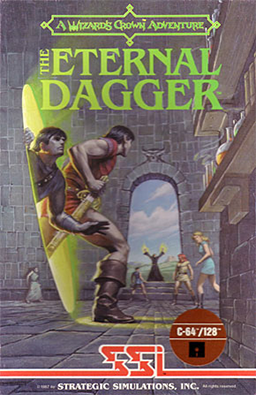The Eternal Dagger
| The Eternal Dagger | |
|---|---|
 |
|
| Developer(s) | Strategic Simulations |
| Publisher(s) | Strategic Simulations |
| Designer(s) | Paul Murray, Victor Penman |
| Platform(s) | Apple II, Atari 8-bit, Commodore 64 |
| Release | 1987 |
| Genre(s) | Adventure, Role-Playing, Strategy |
| Mode(s) | Single player |
The Eternal Dagger is a 1987 top-down role-playing video game published by Strategic Simulations, Inc. (SSI) as a sequel to Wizard's Crown, which was released in 1985. Players can transfer their characters over from Wizard's Crown, minus whatever magical items they had on them.
The story behind the game is that demons from another dimension are invading the world, and the only item that can seal the portal is the titular dagger.
SSI sold 18,471 copies of The Eternal Dagger in North America.Computer Gaming World in 1987 described the gameplay as very similar to that of its predecessor, with a few changed spells and in-battle options. The use of a single character to represent the party was praised, as it eliminated the frustration of party members getting lost or stuck behind walls that was present in Wizard's Crown. Dungeon combat was described as having worsened, however, due to the time spent maneuvering party members into a position where they can attack before they can do so. The review also felt the game did not have the same balance as the previous, with magic being a much more effective option overall. CGW also considered combat to be more difficult in general, with wide discrepancies between the "quick combat" option and tactical combat, and monsters that generally take much longer to kill. The new fatigue, which decreases weapon skill as party members go without rest, was also criticized as lengthening travel time and slowing down the game. Ultimately, the review stated The Eternal Dagger was not of the same quality as its predecessor, and recommended a lot of patience when playing the game. In 1993 the magazine stated that The Eternal Dagger was "not as good as the previous game" and, despite the "interesting plot idea, this game is only for the patient".A.N.A.L.O.G. criticized the game's "overly complex and poorly designed setup procedure and difficult-to-use command structure", but stated that the time needed to finish the game and its predecessor "is 50 hours well spent indeed".
The game was reviewed in 1988 in Dragon #129 by Hartley, Patricia, and Kirk Lesser in "The Role of Computers" column. The reviewers gave the game 1 1⁄2 out of 5 stars.
...
Wikipedia
